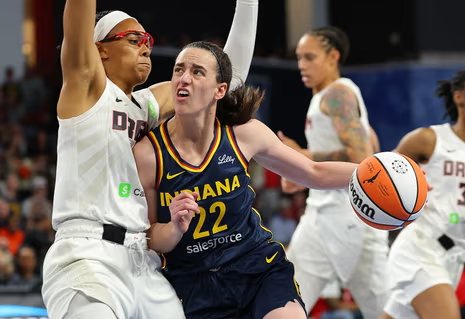“WBB Shaken: Indiana Fever Respond to Caitlin Clark Targeting with Major Adjustments”
The WNBA landscape has been electrified by the arrival of Caitlin Clark, the sensational rookie whose scoring prowess and court vision have made her an instant superstar. However, her transition to the professional level hasn’t been without challenges. Opposing teams have made it clear that they won’t let the former Iowa phenom dominate without resistance, employing aggressive defensive schemes designed to limit her impact. The Indiana Fever, recognizing the need to protect their franchise cornerstone, have responded with significant adjustments aimed at countering the physical targeting of Clark while keeping their offense fluid and competitive.
From the moment Clark stepped onto the WNBA floor, it was evident that defenses would test her. The league’s veterans, known for their physicality and defensive intensity, have made it a point to disrupt her rhythm with hard fouls, tight close-outs, and relentless pressure. This strategy isn’t new—star players often face extra attention—but the frequency and intensity of the targeting have raised eyebrows. Clark, who thrived in college as a high-volume shooter and playmaker, has had to adapt quickly to the increased defensive scrutiny, and the Fever’s coaching staff has been forced to rethink their approach to keep her effective.
One of the most immediate adjustments has been the implementation of more off-ball movement to free Clark from constant defensive pressure. In college, she was accustomed to having the ball in her hands for extended stretches, orchestrating the offense with her elite passing and deep-range shooting. However, WNBA defenses have been quick to trap her on screens and deny her easy touches, forcing Indiana to get creative. The Fever have incorporated more staggered screens, flare actions, and backdoor cuts to prevent opponents from locking in on Clark. By keeping her in motion, the team has made it harder for defenses to key in on her without leaving other players open.
Another critical change has been the emphasis on secondary playmaking. While Clark is undeniably the centerpiece of Indiana’s offense, the Fever have recognized that relying solely on her to create shots makes them predictable. Players like Kelsey Mitchell and NaLyssa Smith have been given more responsibility as ball-handlers in half-court sets, allowing Clark to work off the ball and exploit mismatches. This not only takes some of the defensive pressure off her but also diversifies Indiana’s attack, making them less susceptible to defensive schemes designed to shut down one player. Mitchell, in particular, has thrived in this expanded role, using her scoring ability to keep defenses honest while Clark navigates through traffic.
The Fever have also made subtle but crucial tweaks to their offensive spacing. Early in the season, Indiana often found itself with stagnant floor positioning, allowing defenses to collapse on Clark whenever she drove to the basket. To counter this, the coaching staff has emphasized better floor balance, ensuring that shooters are positioned in the corners and wings to punish teams for overhelping. This adjustment has been particularly effective in creating driving lanes for Clark, who excels at finishing at the rim or kicking out to open shooters when defenses rotate. The improved spacing has not only benefited her but has also opened up opportunities for the Fever’s role players to contribute more consistently.
Defensively, Indiana has had to address the added attention Clark receives by ensuring she isn’t being exploited on the other end of the floor. Some opponents have deliberately targeted her in isolation, testing her ability to hold her own against elite WNBA scorers. While Clark is a capable defender, the Fever have made a concerted effort to provide timely help defense without leaving themselves vulnerable to open three-pointers. By incorporating more zone looks and switching schemes, they’ve been able to mitigate some of the mismatches while keeping Clark engaged defensively without overexerting her.
Perhaps the most significant adjustment, however, has been the psychological and physical support the organization has provided Clark. Transitioning to the WNBA is demanding for any rookie, but the added scrutiny and physicality directed at her could have been overwhelming. The Fever’s veteran leaders, including Erica Wheeler and Temi Fagbenle, have taken on mentorship roles, helping Clark navigate the challenges of being a marked player. Additionally, the coaching staff has worked closely with her to refine her decision-making under pressure, ensuring she remains composed even when defenses throw everything at her.
The results of these adjustments have been promising. While Clark’s scoring numbers may not yet mirror her collegiate dominance, her efficiency has gradually improved as she adapts to the league’s pace and physicality. More importantly, the Fever have shown flashes of cohesion, proving that they can compete when their offensive system is functioning as intended. There’s still work to be done—Indiana’s roster lacks the depth of some of the league’s elite teams, and defensive consistency remains an issue—but the willingness to adapt bodes well for their long-term development.
Looking ahead, the Fever’s ability to sustain these adjustments will be crucial. Opposing teams will continue to test Clark, and as the season progresses, scouting reports will only become more detailed. Indiana must remain proactive, tweaking their strategies to stay ahead of the curve. Whether it’s incorporating more pick-and-roll variations, increasing Clark’s off-ball screening actions, or further diversifying their offensive sets, the Fever’s coaching staff must maintain flexibility.
The broader WNBA audience is watching closely. Caitlin Clark’s arrival has brought unprecedented attention to the league, and how she—and the Fever—handle this early adversity will shape the narrative around her rookie season. If Indiana’s adjustments continue to pay off, they could emerge as a dangerous team as the season progresses. If not, the growing pains may persist longer than hoped.
One thing is certain: the Indiana Fever are fully invested in building around Caitlin Clark, and their willingness to make major adjustments in response to her targeting demonstrates their commitment to her success. The WNBA may have been shaken by her arrival, but the Fever are determined to ensure that Clark doesn’t just survive the league’s physicality—she thrives in spite of it.



